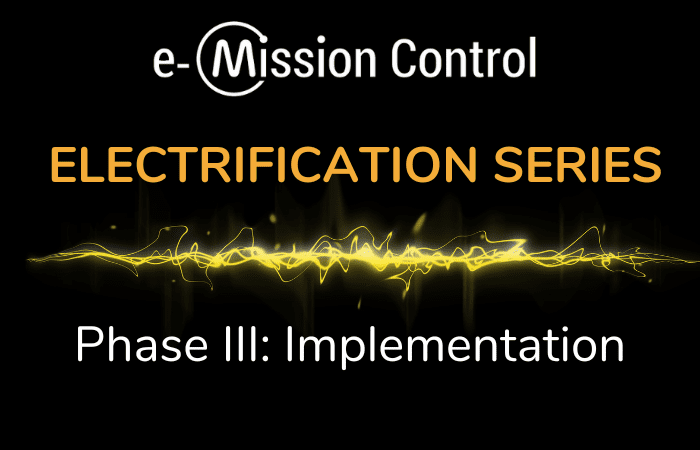
This blog on implementation is the third of a four-part Electrification Transition Timeline series which consists of four main phases: Pre-planning, Budgets and Timelines, Implementation and Results. Here we will focus on the importance of the Implementation phase, specifically in the context of infrastructure site build and installing hardware and software for electric vehicle (EV) transportation. Lastly, this is the phase when clean fuel standard program credits begin to accrue. Early enrollment to maximize credit generation is key. This phase should take between two and nine months to finish.
Your ability to accomplish this implementation phase depends on the completion of your previous two phases, so you may wish to review. Successful electrification starts with pre-planning involving your “why” as well as planning and budgeting, which involves applying for available grants and funding among other steps such as:
The first step in the Implementation phase of the electrification timeline is completing the infrastructure site build. This critical step involves all the necessary construction and installation work to prepare the site for the charging stations. There are several elements to the infrastructure site build including electrical upgrades, civil works, permitting and approvals, and safety and security considerations.
One of the key aspects of the infrastructure site build is ensuring that the electrical infrastructure is upgraded to handle the demands of the charging stations. Depending on the size and number of chargers being installed, the site may require upgrades to the electrical infrastructure to ensure adequate power is available. This could include upgrading the main power supply, installing new electrical distribution panels, and running new electrical lines to the charging stations.
As you wrap up your infrastructure site build, keep in mind to include appropriate signage to ensure that EV drivers can easily find the charging stations and navigate the site. Also, depending on the location and scale of the installation, various permits and approvals may be required from local and state authorities. This can include zoning approvals, building permits, and electrical permits, among others.
Finally, safety and security considerations are paramount in the infrastructure site build. The site should be designed with safety and security in mind, including measures such as lighting, fencing, and surveillance cameras. These measures help to ensure the safety of EV drivers and the security of the charging stations.
The installation of software during the Implementation phase is another essential aspect that can furnish valuable information on the charging behaviors of EVs. Such data can assist fleet operators in streamlining their operations and devising strategies for future expansion.
There are several types of software used to measure and manage EV transportation fleets and charging stations. Here are a few examples of:
These are just a few examples of the types of software used to measure and manage EV transportation fleets and charging stations. As the EV market continues to grow, we can expect to see more advanced software solutions developed to meet the unique needs of this rapidly evolving industry.
Applying for Incentives
The last objective of this phase is to apply for incentives, such as California’s LCFS, Oregon’s CFP, or Washington State’s CFS. These incentives can help offset the costs of electrifying your fleet and make the transition more financially viable.
Clean fuel standard programs typically offer financial incentives or credits for using clean fuels such as electricity, which can help offset the higher upfront costs of EVs and make them more competitive with traditional fossil fuel vehicles.
Another benefit of quarterly participation in clean fuel standard programs is that fleet managers can use these programs to meet regulatory requirements for reducing greenhouse gas emissions. Many states and localities have set targets for reducing emissions from transportation, and participating in clean fuel standard programs can help fleet managers meet these targets by reducing the carbon intensity of their vehicle fleets.
Finally, participation in clean fuel standard programs can help improve the public perception of a fleet and the company as a whole. By demonstrating a commitment to sustainability and reducing emissions, fleet managers can attract environmentally conscious customers and employees and improve their reputation in the community.
In conclusion, the Implementation phase of the electrification timeline is critical for the success of the entire electric transportation industry. Fleet operators or anyone interested in transitioning their transportation fleet to electric should understand the importance of this phase and plan accordingly. The success of the electrification of transportation relies heavily on the proper planning and execution of the Implementation phase.